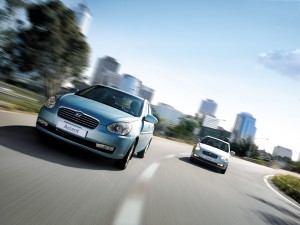
Hyundai stumbles, but inexpensive Accent is up.
For the automakers, May finally offered some hope.
The seasonally adjusted annual rate of sales (SAAR) finally broke through 10 million units for the first time this year, based on preliminary estimates, and even though sales dropped 28% during May, traffic through showrooms and closing picked up noticeably during the last 10 days of the month.
“It’s definitely off the floor,” said Steve Landry, vice president of sales for Chrysler LLC, even though the company’s sales dropped 47% in May, as it continued to pull back from sales when compared to a stronger year earlier period before the financial markets collapsed.
Mike DiGiovanni, GM’s general director of market analysis, also said annualized sales rate of 10.1 million units suggests sales are showing signs of improvement. “We’re starting to see the market take a positive turn,” said DiGiovanni, adding GM’s overall sales dropped 29.6% in May.
Mark LaNeve, GM’s vice president of sales, service and marketing, said pickup truck sales are showing signs of life and pickup trucks sales are very much a leading economic indicator. “The whole industry seemed to pop at the end of the month,” LaNeve said.
Sales have started to improve even though the full-impact of the economic stimulus and cash-for clunkers bill is still winding its way through Congress, said George Pipas, Ford’s sales analyst. “The SAAR is still very weak,” he said.
One of the big winners in May was the Ford – if you can call Ford’s sales drop of 24% a win, which is relatively modest in this context. Year-to-date Ford sales are down 37%. Ford says it was able to pick up retail market share. In addition, Lincoln, a brand that was all but forgotten for most of the past decade, posted a sales increase.
“I think the most encouraging thing about this is that it’s consistent performance, it’s not just a May thing, we’ve been seeing higher retail share for our products since last October, seven of the last eight months we’ve seen retail share gains,” Pipas said.
Ford, which sold 155,924 vehicles in May also, beat Toyota, which sold 152,583, for second spot in total sales, even though its Japanese rival tossed some heavy duty incentives and advertising at the market.
“The big jump in consumer confidence in May translated into a solid gain in retail vehicle sales compared to April,” said Don Esmond, senior vice president of automotive operations for TMS. “We’re encouraged that consumers are beginning to return to showrooms and that the industry continues to show signs of stabilization,” he said.
Overall, though Toyota’s sales dropped 38% last month, while Honda’s fell 34% and Nissan’s dropped 33%. Mazda dropped 40% and Subaru saw its sale fall 5% last month, while Mitsubishi’s dropped 58%. Kia sales dropped 16 %, while Hyundai dropped 14%. This is a relatively large stumble for Hyundai, but year-to-date it is only off 4%.
Volkswagen also posted a 12% sales drop despite a strong showing.
“In this challenging economy, Volkswagen is pleased with our May sales results,” said Mark Barnes, Chief Operating Officer, Volkswagen of America, Inc. “We’re really encouraged by how well our Jetta sedan and SportWagen did in May, and equally excited by how well our TDI clean diesel models continue to sell,” added Barnes. Tiguan and Routan sales also bolstered VW’s sales number.
Audi sales dropped 12%, but it picked up market share in the luxury segment as rivals BMW and Mercedes posted larger declines of 33% and 28%, respectively. Sales of the smart car, one of the few brands to pick up ground this year, also dropped 56%.
LaNeve and Landry also said bankruptcy also had less of an impact on consumers than expected only six months ago “Consumers have been de-sensitized to bankruptcy,” said LaNeve.
